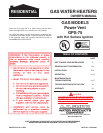
5
not known, the latest edition of National Fuel Gas Code ANSI
Z223.1 recommends using figures of 20-25 percent free area for
wood louvers or 60-75 percent for metal grills or louvers.
UNCONFINED SPACE
In buildings of conventional frame, brick or stone construction,
unconfined spaces may provide adequate air for combustion,
ventilation, and dilution air for power venter.
If the unconfined space is within a building of tight construction
(building using the following construction: weather stripping, heavy
insulation, caulking, vapor barrier, etc.), air for combustion,
ventilation, and venter dilution must be obtained from outdoors.
The installation instructions for confined spaces must be followed.
CONFINED SPACE
When drawing combustion and dilution air from inside a conventionally
constructed building to a confined space, such a space shall be
provided with two permanent openings. ONE WITHIN 12 INCHES
OF THE ENCLOSURE TOP AND ONE WITHIN 12 INCHES OF THE
ENCLOSURE BOTTOM. Each opening shall have a free area of one
square inch per 1000 Btuh of the total input of all appliances in the
enclosure, but not less than 100 square inches.
If the confined space is within a building of tight construction, air for
combustion, ventilation and power venter dilution must be obtained
from outdoors. When directly communicating with the outdoors or
communicating through vertical ducts, two permanent openings,
located in the above manner, shall be provided. Each opening shall
have a free area of not less than one square inch per 4000 Btuh of the
total input of all appliances in the enclosure. If horizontal ducts are
used, each opening shall have a free area of not less than one square
inch per 2000 Btuh of the total input of all appliances in the enclosure.
WATER CONNECTIONS
Refer to figure 1 for typical installation. A suitable pipe thread
sealant must be used to prevent leakage.
WATER (POTABLE) HEATING AND SPACE HEATING
1. All piping components connected to this unit for space heating
applications shall be suitable for use with potable water.
2. Toxic chemicals, such as those used for boiler treatment, shall
NEVER be introduced into this system.
3. This unit may NEVER be connected to any existing heating
system or component(s) previously used with a non-potable
water heating appliance.
4. When the system requires water for space heating at
temperatures higher than required for domestic water purposes,
a tempering valve must be installed. Please refer to Fig. 2 for
suggested piping arrangement.
FIGURE 2
CLOSED WATER SYSTEM
A closed system will exist if a back-flow preventer (check valve),
pressure reducing valve, or other similar device is installed in the cold
water line between the water heater and the street main (or well).
Excessive pressure may develop due to the thermal expansion of
heated water causing premature tank failure or intermittent relief valve
operation. This type of failure is not covered by the limited warranty. An
expansion tank may be necessary in the cold water supply to alleviate
this situation, see Fig. 1. Contact the local plumbing authority.
If the temperature and pressure relief valve on the appliance discharges
periodically, this may be due to thermal expansion in a closed water
supply system. Contact the water supplier or local plumbing inspector
on how to correct situation. DO NOT PLUG THE TEMPERATURE
AND PRESSURE RELIEF VALVE.
GAS CONNECTIONS
The minimum gas supply pressure for input adjustment is 5.0" W.C.
for natural gas (11.0" W.C. for propane).
THE HEATER IS NOT INTENDED FOR OPERATION AT HIGHER THAN
14" WATER COLUMN SUPPLY PRESSURE. EXPOSURE TO
HIGHER GAS SUPPLY PRESSURE MAY CAUSE DAMAGE TO THE
CONTROL WHICH COULD RESULT IN FIRE OR EXPLOSION.
If
overpressure has occurred such as through improper testing of gas
lines or emergency malfunction of the supply system, the control must
be checked for safe operation. Make sure that the outside vents on the
supply regulators and the safety vent valves are protected against
blockage. These are parts of the gas supply system not the heater.
Vent blockage may occur during ice storms.
IT IS IMPORTANT TO GUARD AGAINST CONTROL FOULING
FROM CONTAMINANTS IN THE GAS WAYS. SUCH FOULING
MAY CAUSE IMPROPER OPERATION, FIRE OR EXPLOSION.
All piping must comply with local codes and ordinances or with the
National Fuel Gas Code (ANSI Z223.1 NFPA-54) whichever applies.


















